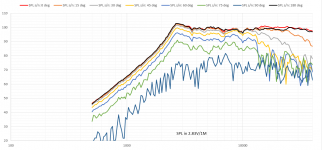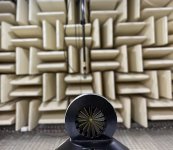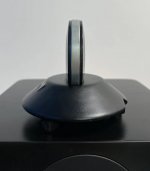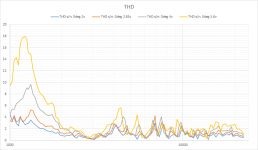We handcrafted the tweeter recently, the test result show as below:

The tweeter is designed for below purpose.
1. A dipole radiation tweeter can work in 3-40kHz, it has a round base so it can mount into your dipole baffle or just put on the box/baffle.
The tweeter has really high sensitivity in its range, about 98-99dB/2.83V from 3-40kHz (even in 4Pi space without addition baffle). The impedance is about 6 ohm (frequency independent).
2. A supper tweeter to work with current commercial system, or your diy projects, due to it has really high sensitivity, flat impedance curve and excellent extend, you can easy design the crossovers, a single capacitor and L-resistor is well done in many conditions.
The tweeter is designed for below purpose.
1. A dipole radiation tweeter can work in 3-40kHz, it has a round base so it can mount into your dipole baffle or just put on the box/baffle.
The tweeter has really high sensitivity in its range, about 98-99dB/2.83V from 3-40kHz (even in 4Pi space without addition baffle). The impedance is about 6 ohm (frequency independent).
2. A supper tweeter to work with current commercial system, or your diy projects, due to it has really high sensitivity, flat impedance curve and excellent extend, you can easy design the crossovers, a single capacitor and L-resistor is well done in many conditions.
Attachments
Last edited:
Cool!
Do you have THD specs? - How low can it be run and stay clean?
I know of someone that would be very interested in a pair of these.
Chris
Do you have THD specs? - How low can it be run and stay clean?
I know of someone that would be very interested in a pair of these.
Chris
the SPL under 90° is relatively high for a dipole speaker - are these reflections of the type of mounting you show at your pictures?
Looks like it looses dipole pattern around 5kHz. But change is compensated smoothly with diameter related directivity. Very interesting!
the SPL under 90° is relatively high for a dipole speaker - are these reflections of the type of mounting you show at your pictures?
I guest some due to the reflection from the base, and the 4pi chamber is not really big and ideally, both will cause the reflection.
You can find some distortion measurements I made on dipole AMT tweeters such as the Neo3/GRS PT2522 and Aurum Cantus AST2560 in this thread:
measurements of nude ribbons and a dome-dipole
If you can revise the design to make the usable low end at least 2kHz that would be a much more comparable, and more useful, product even if sensitivity must be lower.
measurements of nude ribbons and a dome-dipole
If you can revise the design to make the usable low end at least 2kHz that would be a much more comparable, and more useful, product even if sensitivity must be lower.
You can find some distortion measurements I made on dipole AMT tweeters such as the Neo3/GRS PT2522 and Aurum Cantus AST2560 in this thread:
measurements of nude ribbons and a dome-dipole
If you can revise the design to make the usable low end at least 2kHz that would be a much more comparable, and more useful, product even if sensitivity must be lower.
Thank you! I will pay time to study the result.
Sure but maybe not now, although I realize that this is perhaps one of the most competitive supper-tweeters in the world----consider its very good extend and high sensitivity, well usability, especially above 10kHz the THD become less effect IMO.
let us make it more stable, and maybe better performance.
let us make it more stable, and maybe better performance.
- Home
- Loudspeakers
- Multi-Way
- A novelty dipole air motion tweeter




